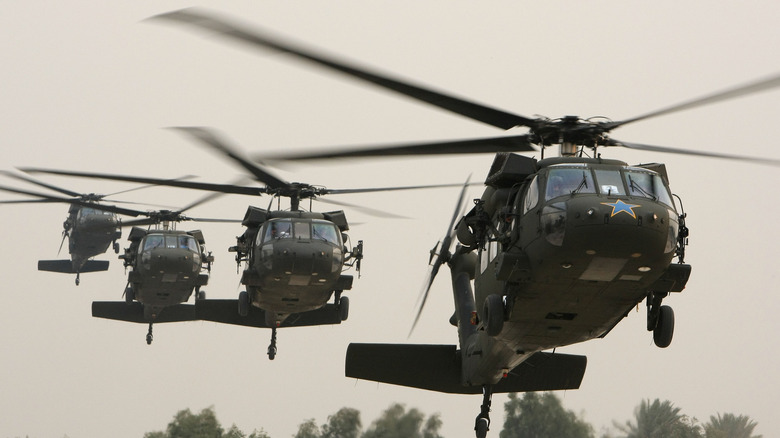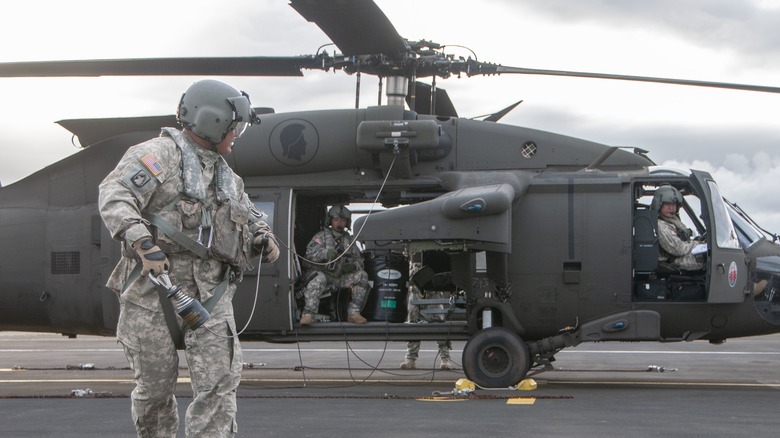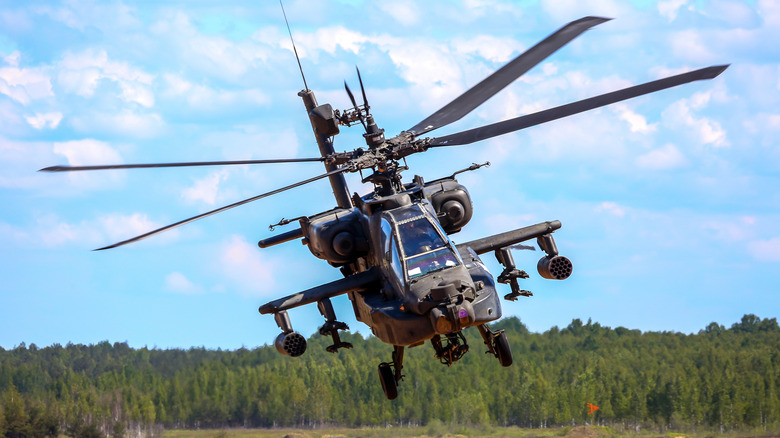Black Hawk Vs. Apache: What's The Difference Between These Military Helicopters?
Every branch of the United States military has access to aerial vehicles in one form or another. The Army's specialty is helicopters, of which it uses a variety to fulfill several roles. The AH-64 Apache is one of the most iconic attack helicopters at the Army's disposal, and it is also one of the most advanced helicopters in the U.S. military's arsenal, only rivaled by the ultimate attack helicopter: the AH-1Z Viper. The AH-64 Apache is one of the most dangerous helicopters across the world.
Then there's the UH-60 Black Hawk. While not nearly as lethal as the Apache due to it fulfilling more of a support role, people worldwide recognize it at first sight. Popularized from the book and movie "Black Hawk Down," the UH-60 has been in operation for 50 years, transporting soldiers to and from bases, rescuing them from combat zones, and providing additional artillery in an air assault. Both choppers couldn't be more different from each other, fulfilling opposite yet vital roles while highlighting two function of the United States Army: support and engagement.
The UH-60A/L Black Hawk is used primarily for utility
The UH-60A/L Black Hawk helicopter is a support chopper that replaced the Vietnam era UH-1 Huey. The UH-60A entered service with the 101st Combat Aviation brigade of the 101st Airborne Division in June 1979. By 1989, Sikorsky began modifying the helicopter, which became the UH-60L Black Hawk. It also made several variants of the chopper, such as the SH-60B Seahawk for the U.S. Navy.
With the A model's capacity for 11 fully equipped combat soldiers in addition to a pilot, co-pilot, and two crew chiefs, the Black Hawk filled a number of support roles from reconnaissance to medevac. Technically, the UH-60A doesn't have any weapons, but it's not without its defenses. That's because each chopper can be outfitted as needed because of the two pintle mounts on each side of the airframe.
A variety of weapons, including an M-60 GP 7.62mm machine gun, a .50 caliber GAU-19/A machine gun, and the General Electric M134 7.62mm 6-barreled minigun can be mounted onto the pintle mounts, giving the Black Hawk some versatility. This is one of the reasons the Black Hawk has survived in the U.S. Army for over 40 years. There's also the External Stores Support System (ESSS), giving access to two wing-like features that can each support up to 5,000 pounds. Some of the equipment the army loads on the support system are 450-gallon and 230-gallon fuel tanks or a variety of missiles, including 16 Hellfires.
The Apache is one of the most threatening attack helicopters in the arsenal
Boeing's AH-64 Apache is considered one of the best attack helicopters ever used in war. This attack helicopter has been in service in the U.S. Army since 1984, and the AH-64A and AH-64E are set to remain in production until at least 2028.
One of the many impressive features on the Apache is its ability to fire the AGM-114 Hellfire missile. Known as a tank killer, this is a laser-guided anti-tank missile that could be fired from nearly five miles away — well out of range of even an Abrams tank cannon. However, the newer AH-64E now comes with the new Joint Air to Ground Missile (JAGM), of which there is a variant that doubles the range of the Hellfire missile. Paired with its 70mm Hydra rocket pods and 30mm M230 chain gun, which can fire 625 rounds per minute, the Apache could theoretically take out an entire armored battalion, and then provide air support for ground troops.
Not only can Apache pilots take out targets from a great distance, but the helicopter is also loaded up with a variety of sensors that improve weapon precision. The Target Acquisition and Designation Sight/Pilot's Night Vision Sensor (TADS/PNVS), for example, highlights targets that are running hot temperatures, such as tanks. This renders certain forms of cover like the darkness of night, smoke, or foliage, useless. The Apache also sports a four-blade main rotor system that gives it exceptional maneuverability.


